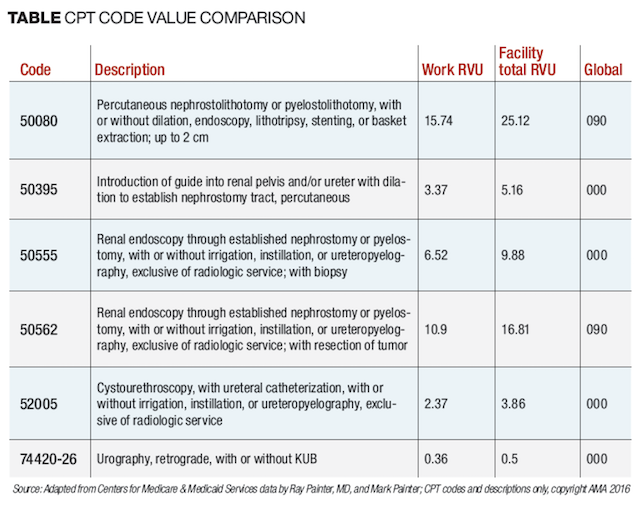Article
How to code for robotic cystolithotomy, diverticulectomy
Author(s):
"When submitting an unlisted code for a procedure, you of course need to submit your documentation and we recommend a cover letter or explanation of the service including a comparative value or charge based on a similar code," write Ray Painter, MD, and Mark Painter.


Correction: An earlier version of this article contained an error. In a question and answer discussing vasectomy coding, the statement, “Code 55450 remains an active CPT code and can be used to report a sterilization procedure in which the vas deferens is ligated with a suture and no portion of the cord is removed or cut,” was incorrect. Code 55450 has been deleted. Code 55250 (Vasectomy, unilateral or bilateral (separate procedure), including postoperative semen examination[s]) is the correct code to use. The corrected response can be read here.
A patient has a large bladder stone (~3.5 cm), part of which is trapped in a bladder diverticulum. How should I bill robotic cystolithotomy along with robotic diverticulectomy?
There are no specific codes for either the laparoscopic (robotic) diverticulectomy nor cystolithotomy. From a pure coding perspective, the proper code would thus be 51999 (Unlisted laparoscopy procedure, bladder). When submitting an unlisted code for a procedure, you of course need to submit your documentation and we recommend a cover letter or explanation of the service including a comparative value or charge based on a similar code. Your staff is likely aware that you may be able to attach supporting documentation electronically at the time you submit the claim through your practice management system or clearinghouse to save some time.
If we explore codes outside of the laparoscopic (robotic) code series, CPT does have codes 51050 (Cystolithotomy, cystotomy with removal of calculus, without vesical neck resection) and 51525 (Cystotomy; for excision of bladder diverticulum, single or multiple [separate procedure]). According to the National Correct Coding Initiative, you should code only 51050, as code 51525 is included in 51050. Note that unbundling is never allowed. This type of bundling edit is common with codes designated as “(separate procedures).”
Also by the Painters:When can modifier –25 be used with an E/M code?
When reporting the unlisted code, we would recommend including a value-based comparison to code 51050 that may also include a documented increase in work effort due to the size of the stone and inclusion of the diverticulectomy, if appropriate (ie, the procedure took 150% of the time for a standard cystolithotomy due to large size of the stone and difficulty of extracting the stone from the diverticulum including repair of the bladder).
As an alternative, some payers may be willing to accept the 51050-22. The description of procedure code 51050 does not specify the procedure as open in the description.
However, the approach of using the traditionally “open” procedure code for a laparoscopic (robotic) procedure is not widely accepted, thus our initial recommendation for code 51999. The method of coding for laparoscopic codes using traditional “open approach” codes has been endorsed by some payers and is mentioned as an option for coding by AUA representatives for the laparoscopic (robotic) cystectomy.
As is common with these difficult coding conundrums, we encourage you to check with the payer prior to reporting in this way.
Next: Coding a percutaneous tumor resection
I am an endourologist at the University of Michigan with a question regarding coding of percutaneous tumor resection of a large upper tract urothelial cancer. For these cases, I perform a cystoscopy and retrograde pyelogram (52005, 74420) to assist my colleague with getting percutaneous access (50395). I then perform a resection of the tumor percutaneously. This is quite an involved surgery that is more similar to a percutaneous nephrolithotomy than anything else. My coders tell me that despite the complexity of the surgery (sometimes it takes 3 hours), we are supposed to use the renal endoscopy with biopsy code (50555, work relative value unit 6.5) rather than nephroscopy through nephrotomy codes (50574, etc.). The difference in RVU is tremendous. What are your thoughts on how to code a percutaneous tumor resection? I would expect it to be closer to a PCNL.
Your list of codes (descriptions listed in table below) for establishing the access-52005, 74420-26-and your colleague’s (assuming he/she is from a different specialty/practice) coding of 50395 are accurate.
Read -Medicare final rule: Urologists’ pay set to decrease (again)
We are puzzled by your coders’ recommendation to use code 50555 (Renal endoscopy through established nephrostomy or pyelostomy, with or without irrigation, instillation, or ureteropyelography, exclusive of radiologic service; with biopsy), when code 50562 (Renal endoscopy through established nephrostomy or pyelostomy, with or without irrigation, instillation, or ureteropyelography, exclusive of radiologic service; with resection of tumor) appears to be more descriptive of the procedure, assuming that you are using renal endoscopy to resect the tumor as the overall question implies.

Code 50562 does carry a 90-day global as opposed to code 50555, most likely due to the longer follow-up required for a treatment as opposed to a diagnostic biopsy. As you can see from the table, code 50562 has a work RVU closer to the PCNL code 50080.
In summary, you would bill Medicare 50562, 52005 (if billing to a private payer, add modifier –51), and 74420-26, and your colleague would bill 50395.
Also see:How to get reimbursed for BPH water vapor ablation
If you are performing the resection without the use of renal endoscopy, your coders may be referencing a different code set for which there is no resection of tumor code.
Next: Vasectomy coding
For vasectomy coding, when is it appropriate to use 55450 instead of 55250? My coder is telling me that 55450 is an outdated code that should no longer be used.
Code 55450 (ligation [percutaneous] of vas deferens, unilateral or bilateral [separate procedure]) has finally been deleted, removing the confusion for all. Vasectomies are reported with code 55250 (vasectomy, unilateral or bilateral [separate procedure], including postoperative semen examination[s]).
Send coding and reimbursement questions to Ray Painter, MD, and Mark Painter c/o Urology Times, at UT@advanstar.com. Questions of general interest will be chosen for publication. The information in this column is designed to be authoritative, and every effort has been made to ensure its accuracy at the time it was written. However, readers are encouraged to check with their individual carrier or private payers for updates and to confirm that this information conforms to their specific rules.

















